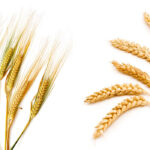Hot and dry weather saw crop conditions decline across much of Western Canada over the past month, with the latest model-based production estimates from Statistics Canada showing downward revisions in both canola and wheat production from the August report.

StatCan revises canola production lower

Alberta cereals harvest surprisingly resilient
Dryland farmers in the south took a hit, but other regions pulled up the provincial average
Reading Time: 4 minutes Alberta’s cereal crop production wasn’t terrible this year, but only if judging by provincial averages. Alberta Financial Services Corporation publishes the provincial crop report along with field staff at Alberta Agriculture and Irrigation. As harvest unfolds, they’ve seen total yield estimates rise week by week. In its most recent edition, barley yield expectations increased by […] Read more

Vietnam to call off thistle seed ban in grain imports
Move will restore regular grain trade, Cereals Canada says
Vietnam is expected to resume nearer-to-normal grain trade with exporting nations such as Canada, after it loosens a significant restriction on weed seed content. Cereals Canada, a national cereals industry group, on Friday reported that Vietnam’s agriculture ministry has released a revised quarantine pest list due to take effect Sept. 29. The new list, Cereals […] Read more

Cereal producers back merger but it won’t happen overnight, say officials
Amalgamating Alberta Wheat and Alberta Barley is complicated but should be done by summer
Reading Time: 3 minutes A merged wheat and barley commission will be up and running by August after Alberta growers overwhelmingly voted to amalgamate the two groups. “August 1 would be the ideal launch date (as) July 31 is the end of our fiscal year,” said Tom Steve, general manager for both groups, which merged their leadership and administrative […] Read more

Saskatchewan’s harvest 90 per cent complete
MarketsFarm — Excellent weather over the week ended Monday saw Saskatchewan farmers make good harvest progress, with 90 per cent of the province’s crops off the field, according to the latest provincial report. Harvest progress was up from 81 per cent the previous week — and from the five-year average of 82 per cent. While […] Read more

Saskatchewan crops advancing quickly
MarketsFarm — Hot and humid conditions saw crops in Saskatchewan advance quickly during the week ended Monday, according to the latest provincial crop report — although the humidity has slowed haying. When humidity is high, cutting hay becomes more challenging and hay that is cut does not dry down as quickly, which can result in […] Read more

Planting progress picking up in Saskatchewan
MarketsFarm — Overall spring planting across Saskatchewan reached 33 per cent complete as of Monday, according to the latest weekly crop report from Saskatchewan Agriculture. Despite the good progress over the week, that’s still 20 points behind the five-year average. When compared to the excellent progress this time last year, the gap expands to 41 […] Read more

Alberta cereal commissions ‘halfway there’ on merger vote
If wheat growers vote in favour next month, a plebiscite will be held on sealing the deal
Reading Time: 3 minutes Alberta Barley is one step closer to amalgamating with Alberta Wheat following a vote in favour of the proposal at the barley growers’ annual general meeting early this month. “At our AGM last week, the Alberta Barley delegates voted highly in favour of moving forward,” said chair Tara Sawyer. “Now the next step is the […] Read more

Ag department lowers crop production, export estimates
Expectations knocked down for most major Prairie crops
MarketsFarm — Canadian crop production will be down significantly in the 2021-22 marketing year, cutting into exports for all of the country’s major grains, oilseeds and pulse crops. That’s the estimation from the latest supply/demand estimates from Agriculture and Agri-Food Canada (AAFC), released Thursday. Total field crop production for all crops is forecast to decrease […] Read more

Manitoba triggers hay disaster benefit
Per-tonne rate lifted to cover feed, transport costs
Manitoba’s crop insurance agency is set to lift the per-tonne rate paid out on insured forage crops to help cover livestock producers’ bills to buy and truck in replacement feed. Manitoba Agricultural Services Corp. (MASC) on Thursday announced a 2021 hay disaster benefit to provide another $44 per tonne, for every tonne below coverage, to […] Read more

